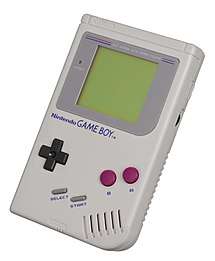VisualBoyAdvance
 | |
| Original author(s) | Julian Henry Hitchcock |
|---|---|
| Developer(s) | VBA Team |
| Stable release |
1.7.2 (Windows) 1.7.1 (Linux, BeOS) 1.7.4 (Mac) / May 25, 2004 |
| Preview release |
1.8.0 beta 3
/ October 1, 2005 |
| Written in | C, C++ |
| Operating system | Cross-platform |
| Size | 1.4 MB - 1.92 MB |
| Available in | English, French, German, Italian, Polish, Portuguese, Chinese, Spanish, Turkish (v.1.7 and above, for Windows only) |
| Type | Console emulator |
| License | GNU General Public License |
| Website |
sourceforge |
 | |
| Original author(s) | Julian Henry Hitchcock |
|---|---|
| Developer(s) | VBA-M Development Team |
| Stable release |
2.1.0[1]
/ 1 July 2018 |
| Operating system | Cross-platform |
| Type | Console emulator |
| License | GNU General Public License |
| Website |
vba-m |
VisualBoyAdvance (commonly abbreviated as VBA) is a free emulator of the Game Boy, Game Boy Color, and Game Boy Advance handheld game consoles[2] as well as of Super Game Boy and Super Game Boy 2.
Besides the DirectX version for the Windows platform, there is also one that is based on the free platform independent graphics library SDL. This is available for a variety of operating systems including Linux,[3] BSD, Mac OS X,[4] and BeOS. VisualBoyAdvance has also been ported to AmigaOS 4, AROS, GameCube, Wii, webOS, and Zune HD.[5]
History
The VisualBoyAdvance project was started by "Forgotten".[6] When this person left the development of the emulator, the project was handed over to a team named "VBA Team", led by Forgotten's brother. Development on the original VisualBoyAdvance stopped in 2004 with version 1.8.0 beta 3, and a number of forked versions were made by various developers in the years since then, such as VisualBoyAdvance-M.
VisualBoyAdvance-M
VisualBoyAdvance-M, or simply VBA-M, is an improved fork from the inactive VisualBoyAdvance project, adding several features as well as maintaining an up-to-date codebase. After VisualBoyAdvance became inactive in 2004, several forks began to appear such as VBALink, which allowed users to emulate the linking of two Game Boy devices. Eventually, VBA-M was created, which merged several of the forks into one codebase. Thus, the M in VBA-M stands for Merge. There is also a RetroArch/Libretro port of VBA-M's GBA emulation core (without the GB, GBC and SGB cores)[7] as well as a modified version called VBA-Next.[8]
Features
VisualBoyAdvance sports the following features:
- Compatibility with Game Boy, Game Boy Color, and Game Boy Advance ROMs
- Import/export feature of native saved games from and to other emulators
- Full save state support
- Joystick support
- Super Game Boy and Super Game Boy 2 border and color palette support
- Game Boy Printer emulation
- Real-time IPS patching (used mostly to play fan translations)
- Hacking and debugging tools, including loggers, viewers and editor
- The SDL version also includes a Game Boy Advance debugger
- Auto-fire support
- Speed-up key
- Full screen mode support
- Screen capture support
- Full support for GameShark for Game Boy Advance and Code Breaker Advance cheat codes (Windows version only)
- Audio (WAV) and video (AVI) recording
- Also allows recording in a proprietary video format only supported by VisualBoyAdvance and its forked versions
- Graphic filters to enhance display: 2xSaI, Super 2xSaI, Super Eagle, AdvanceMAME, Pixelate, and Motion blur
- GUI skinning support
In addition, VisualBoyAdvance-M adds the following:
- HQ3x/4x pixel filters
- Gameboy linking, over LAN and Internet
In conjunction with the Dolphin GameCube emulator, VBA-M supports linking GameCube and Game Boy Advance titles.[9][10]
Critical security flaw
The VBA emulator is vulnerable to arbitrary code execution through a feature that allows importation of cheat codes from files, which isn't protected against buffer overrun. By importing a malicious XPC file (usually containing a list of GameShark cheat codes), VBA and VBA-rr can execute arbitrary code contained within the file.
Proof-of-concept XPC files have been written for VBA 1.8.0 and VBA-rr,[11] but VBA-M is currently not known to be vulnerable.
See also
References
- ↑ Github - Latest Release
- ↑ "Visual Boy Advance". The Emulator Zone.
- ↑ i"VisualBoyAdvance-SDL". The Linux Game Tome.
- ↑ "VisualBoyAdvance 1.7.2". Softonic.
- ↑ "Visual Boy Advance GX". Google Code.
- ↑ "Visual Boy Advance". NGEmu. Archived from the original on 2009-12-17. Retrieved 2009-11-18.
- ↑ https://github.com/visualboyadvance/vbam-libretro
- ↑ https://github.com/libretro/vba-next
- ↑ "Dolphin Progress Report: March 2015". Dolphin Emulator. 1 April 2015.
- ↑ "Preliminary update to the GameCube to GBA link cable emulation. Fixes… · visualboyadvance-m/visualboyadvance-m@f1e3094".
- ↑ "VBA 1.8.0 & VBA-RR: Stack buffer overflow in XPC file parser results in code execution". TheZZAZZGlitch. 12 September 2016.
External links
| Wikimedia Commons has media related to VisualBoyAdvance. |
